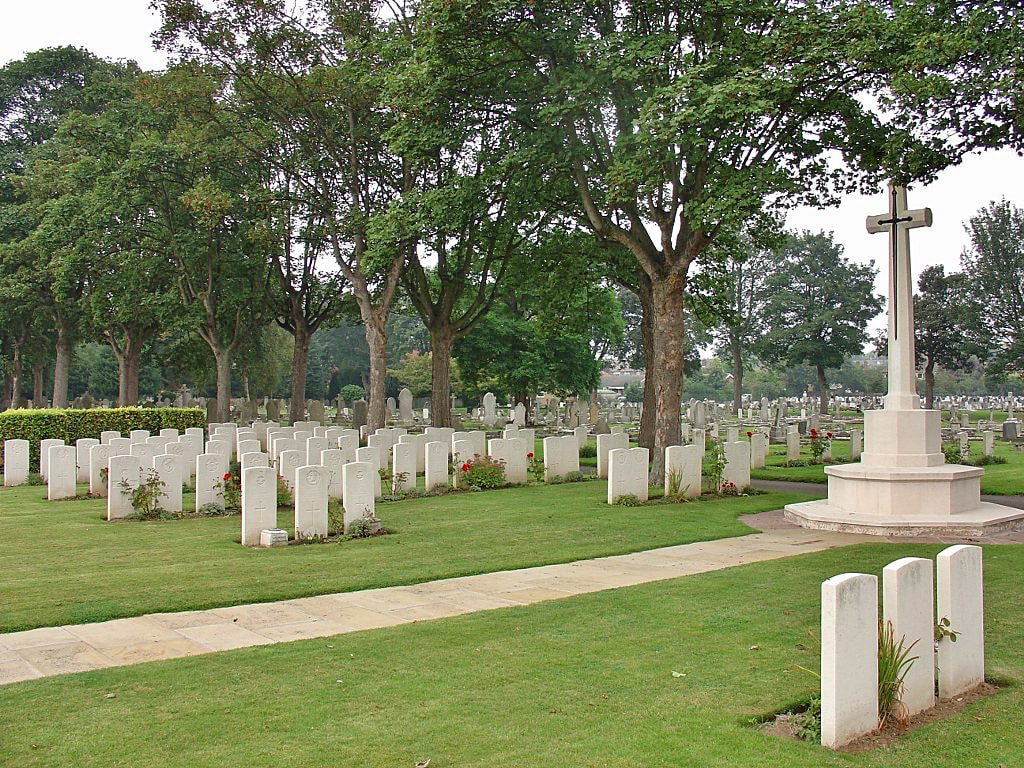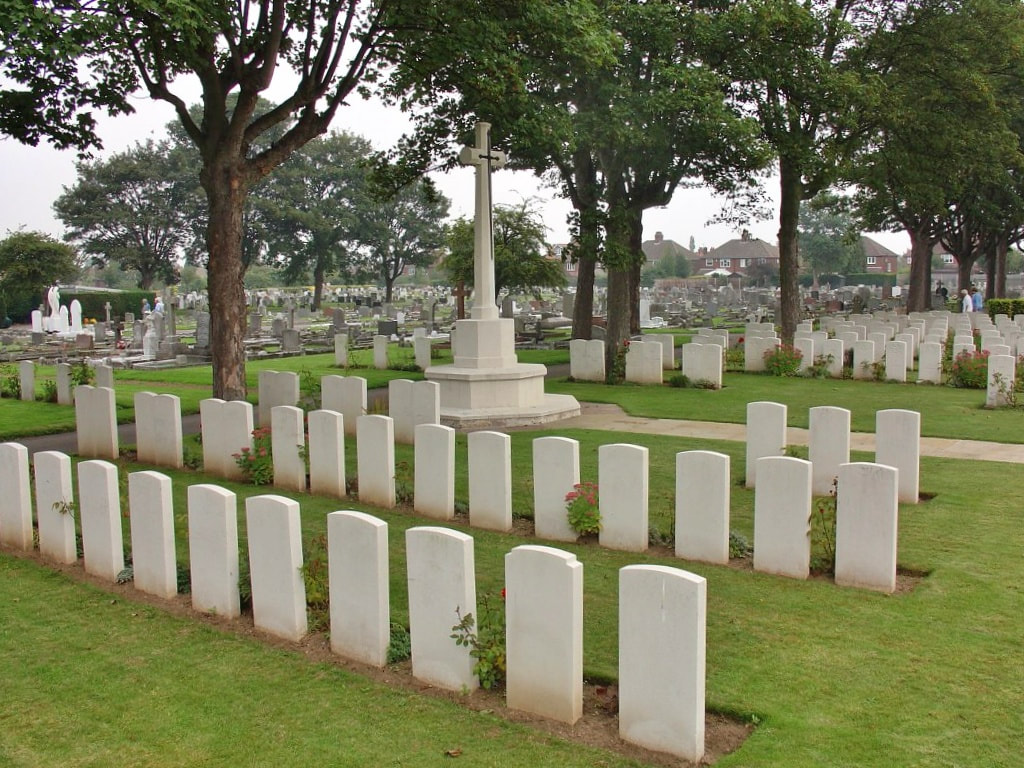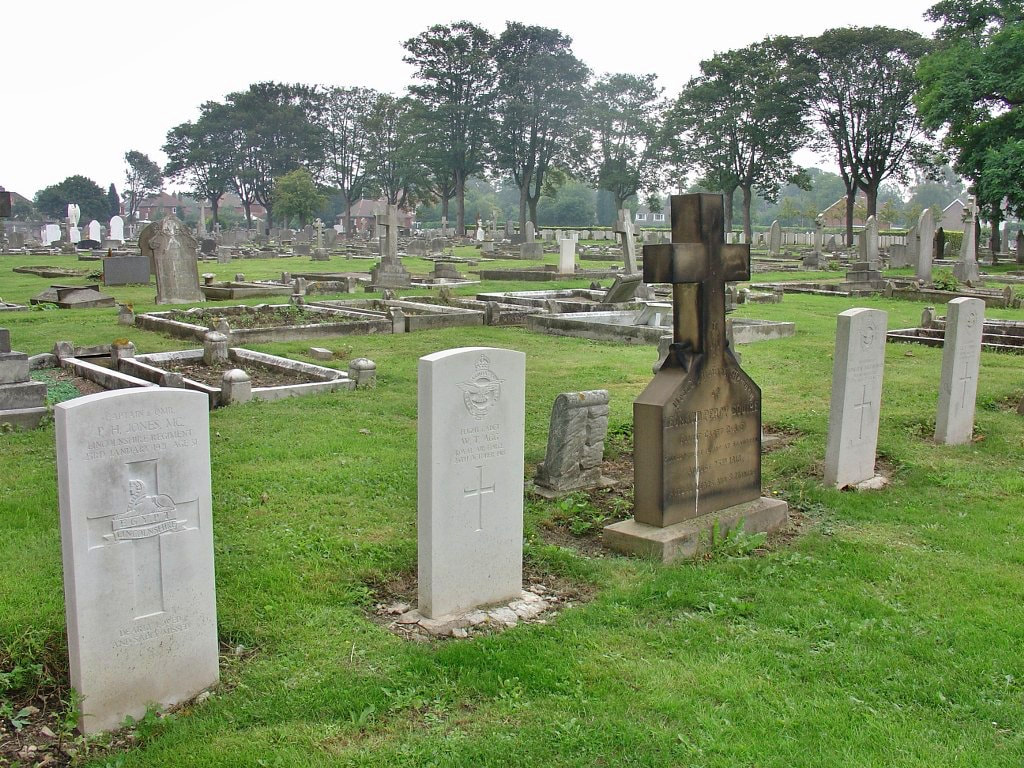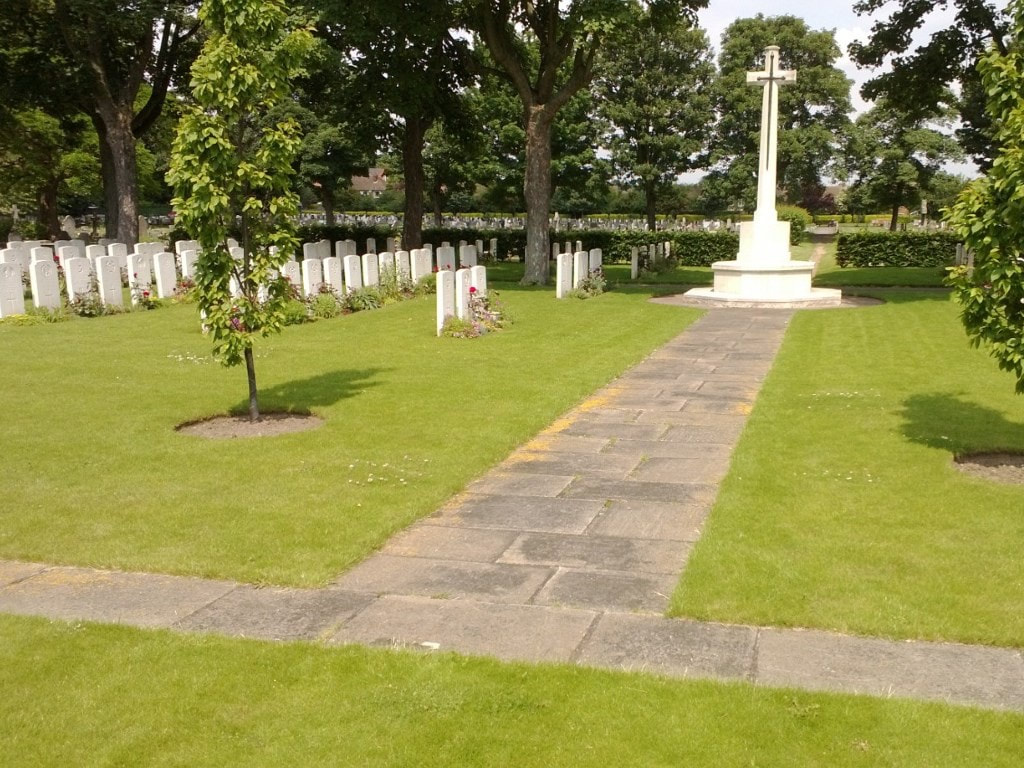LINCOLN (NEWPORT) CEMETERY
Lincolnshire
England
GPS Coordinates: Latitude: 53.2401, Longitude: -0.53267
Location Information
Lincoln (Newport) Cemetery is on the north-western side of the city adjoining St. Nicholas Churchyard.
Visiting Information
A Visitor Information Panel was recently installed at Lincoln (Newport) Cemetery to provide information about the war casualties buried here. This is one of many panels being erected to help raise awareness of First and Second World War graves in the UK (Sep 2013).
Historical Information
During the First World War, the 4th Northern General Hospital was at the Grammar School in Lincoln. the hospital had 1,400 beds and during the course of the war, admissions numbered 45,000. Lincoln (Newport) Cemetery, which was near the hospital, contains 139 First World War burials, almost 90 of them forming a war graves plot. During the Second World War, this plot was extended and most of the 120 burials from this period were made there. The rest of the graves from both wars are scattered throughout the cemetery.
Total Commission Burials: 281.
World War One Casualties: United Kingdom 125, Canada, Australia 5, U. S. A. 1. Total 140.
World War Two Casualties: United Kingdom 98, Canada 18, Australia 1, New Zealand 1, Poland 1. Total 119.
Lincoln (Newport) Cemetery is on the north-western side of the city adjoining St. Nicholas Churchyard.
Visiting Information
A Visitor Information Panel was recently installed at Lincoln (Newport) Cemetery to provide information about the war casualties buried here. This is one of many panels being erected to help raise awareness of First and Second World War graves in the UK (Sep 2013).
Historical Information
During the First World War, the 4th Northern General Hospital was at the Grammar School in Lincoln. the hospital had 1,400 beds and during the course of the war, admissions numbered 45,000. Lincoln (Newport) Cemetery, which was near the hospital, contains 139 First World War burials, almost 90 of them forming a war graves plot. During the Second World War, this plot was extended and most of the 120 burials from this period were made there. The rest of the graves from both wars are scattered throughout the cemetery.
Total Commission Burials: 281.
World War One Casualties: United Kingdom 125, Canada, Australia 5, U. S. A. 1. Total 140.
World War Two Casualties: United Kingdom 98, Canada 18, Australia 1, New Zealand 1, Poland 1. Total 119.
Images in gallery below used with the permission of the Commonwealth War Graves Commission
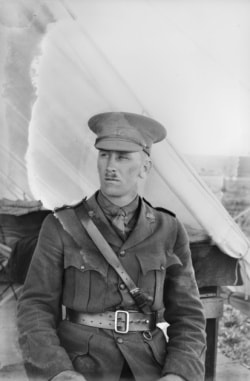
Second Lieutenant
Harold Strachan Kitson
Australian Flying Corps
15th June 1917, aged 22.
D. 454.
Son of James and Annie Kitson, of 30, Studley Avenue, Kew, Melbourne, Australia.
His headstone bears the inscription "He Heard The Call, He Stood The Test He Died A Hero, One Of The Best"
Outdoor portrait of Lieutenant (Lt) Harold Strachan Kitson, Australian Flying Corps from Melbourne, Victoria. He was a 22 year old engineering student when he enlisted on 5 October 1916 and embarked for overseas as a Second Lieutenant with C Flight, No 2 Squadron from Melbourne on 25 October 1916 aboard HMAT Ulysses. After serving with the 68th and the 63rd Squadrons, Royal Flying Corps, Lt Kitson was killed on 15 June 1917 in an aeroplane accident three miles north east of South Carlton, near Lincoln, England and is buried in the Newport Cemetery, Lincoln.
Harold Strachan Kitson
Australian Flying Corps
15th June 1917, aged 22.
D. 454.
Son of James and Annie Kitson, of 30, Studley Avenue, Kew, Melbourne, Australia.
His headstone bears the inscription "He Heard The Call, He Stood The Test He Died A Hero, One Of The Best"
Outdoor portrait of Lieutenant (Lt) Harold Strachan Kitson, Australian Flying Corps from Melbourne, Victoria. He was a 22 year old engineering student when he enlisted on 5 October 1916 and embarked for overseas as a Second Lieutenant with C Flight, No 2 Squadron from Melbourne on 25 October 1916 aboard HMAT Ulysses. After serving with the 68th and the 63rd Squadrons, Royal Flying Corps, Lt Kitson was killed on 15 June 1917 in an aeroplane accident three miles north east of South Carlton, near Lincoln, England and is buried in the Newport Cemetery, Lincoln.
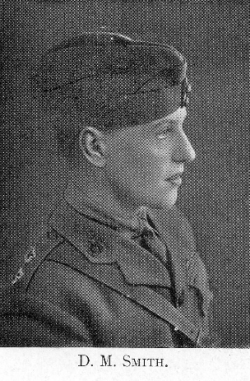
Lieutenant
Donald McQuistan Smith
Central Despatch Pool, Royal Air Force
20th August 1918, aged 19.
C. D. Red. 23.
Son of Percy and Lucy Mary Smith, of "Brookland," Uppleby Rd., Parkstone, Dorset. Born at Wallasey, Cheshire.
His headstone bears the inscription "Pro Patria Dimicans"
The information below supplied by 'The Ellesmerian Club', the alumni organisation for Ellesmere College where Donald was a pupil.
Donald McQuistan Smith
Central Despatch Pool, Royal Air Force
20th August 1918, aged 19.
C. D. Red. 23.
Son of Percy and Lucy Mary Smith, of "Brookland," Uppleby Rd., Parkstone, Dorset. Born at Wallasey, Cheshire.
His headstone bears the inscription "Pro Patria Dimicans"
The information below supplied by 'The Ellesmerian Club', the alumni organisation for Ellesmere College where Donald was a pupil.
Donald McQuistan Smith arrived at Ellesmere College together with his brother, Percy Stuart, at half term in the Lent Term 1913 and they both left at the end of that year. There were twenty two new boys admitted to the college that term and both boys were placed in the ‘Woodard’ dormitory.
A large number of that term’s intake went on to serve their country in one way when the call to arms came. Many were simply too young to enlist and could only join the forces as cadets or boy soldiers.
The only comment that The Ellesmerian makes about the brothers’ stay is that they represented the ‘Woodard’ dormitory at rugby and cricket, although never on the winning side.
After he left Ellesmere, Donald went to work for a Mr. Oakley, a farmer at the Grange, Uppingham until he joined the Royal Flying Corps, on 14th May 1917. On completing his initial training he was sent to Hendon in August to learn how to be a pilot. From then he was with various training squadrons until January 1918 when he joined No. 2 Squadron.
He had been appointed 2nd Lieutenant (on probation) on 16th August 1917 and he became 2nd Lieutenant, Flying Officer Smith on 27th January 1918.
He was, however, in a London hospital throughout April 1918 which is most likely why he was not in the front line but part of the Central Despatch Pool when he was declared fit for duty on 6th May 1918.
His flying career did not last much longer for Donald was injured on 17th July when the Camel single seater fighter bi-plane E1517 which he was flying, had to make a forced landing and impacted with a hedge. He survived the crash and the subsequent inquiry learnt that he had crawled under the machine to reach the Holt flare but was struck by the propeller and the fuel ignited. He died from his injuries on 20th August at the 4thNorthern General Hospital, Lincoln. Nine other pilots lost their lives that day.
The funeral took place on 24th August at St. Nicholas Cemetery, Lincoln close to the hospital where he died. One hundred and thirty-nine of his comrades keep him company. Donald was just nineteen years old. On his headstone is engraved the college motto “Pro Patria Dimicans”
Although Donald was born in Wallasey, Cheshire, on 3rd December 1898, at the time of his death, his mother Lucy Mary was living at “Brooklands”, Uppleby Road, Parkstone, Dorset. His father, Percy, who had been an insurance broker, had died a few years before Donald’s death.
A large number of that term’s intake went on to serve their country in one way when the call to arms came. Many were simply too young to enlist and could only join the forces as cadets or boy soldiers.
The only comment that The Ellesmerian makes about the brothers’ stay is that they represented the ‘Woodard’ dormitory at rugby and cricket, although never on the winning side.
After he left Ellesmere, Donald went to work for a Mr. Oakley, a farmer at the Grange, Uppingham until he joined the Royal Flying Corps, on 14th May 1917. On completing his initial training he was sent to Hendon in August to learn how to be a pilot. From then he was with various training squadrons until January 1918 when he joined No. 2 Squadron.
He had been appointed 2nd Lieutenant (on probation) on 16th August 1917 and he became 2nd Lieutenant, Flying Officer Smith on 27th January 1918.
He was, however, in a London hospital throughout April 1918 which is most likely why he was not in the front line but part of the Central Despatch Pool when he was declared fit for duty on 6th May 1918.
His flying career did not last much longer for Donald was injured on 17th July when the Camel single seater fighter bi-plane E1517 which he was flying, had to make a forced landing and impacted with a hedge. He survived the crash and the subsequent inquiry learnt that he had crawled under the machine to reach the Holt flare but was struck by the propeller and the fuel ignited. He died from his injuries on 20th August at the 4thNorthern General Hospital, Lincoln. Nine other pilots lost their lives that day.
The funeral took place on 24th August at St. Nicholas Cemetery, Lincoln close to the hospital where he died. One hundred and thirty-nine of his comrades keep him company. Donald was just nineteen years old. On his headstone is engraved the college motto “Pro Patria Dimicans”
Although Donald was born in Wallasey, Cheshire, on 3rd December 1898, at the time of his death, his mother Lucy Mary was living at “Brooklands”, Uppleby Road, Parkstone, Dorset. His father, Percy, who had been an insurance broker, had died a few years before Donald’s death.


